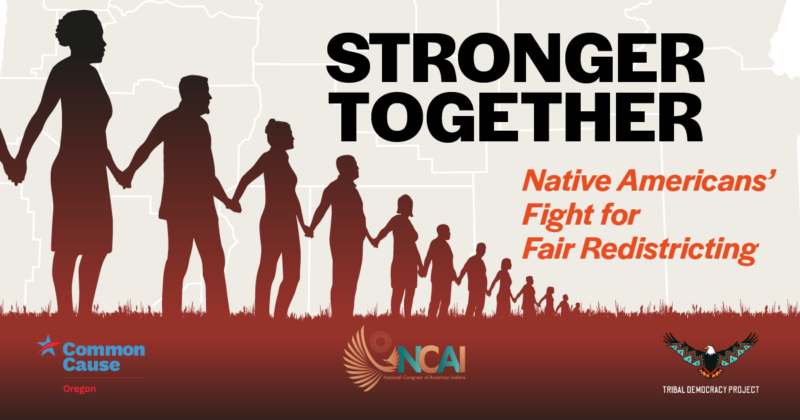Press Release
New Report Examines Redistricting Impact on Native American Communities Post-2020 Census
The report focuses particularly on Arizona, Alaska, South Dakota, Oregon, Minnesota, and New Mexico - states with some of the highest population share of Native Americans based on the 2020 Census. It highlights the challenges and successes of the redistricting cycle from the perspective of Native community leaders and organizers, points to lessons learned, and offers a set of recommendations for the future.
Related Issues

A new report from Common Cause examines the impact of the recent redistricting cycle on Native American communities. “Stronger Together: Native Americans’ Fight for Fair Redistricting,” looks at the attempts to undermine the Native American vote through gerrymandering and how a number of them were foiled.
The report focuses particularly on Arizona, Alaska, South Dakota, Oregon, Minnesota, and New Mexico – states with some of the highest population share of Native Americans based on the 2020 Census. It highlights the challenges and successes of the redistricting cycle from the perspective of Native community leaders and organizers, points to lessons learned, and offers a set of recommendations for the future.
“Native American communities achieved a number of remarkable successes this redistricting cycle despite a census conducted during a pandemic and the fact that it was the first cycle since the Supreme Court’s disastrous Shelby County ruling gutted the protections of the Voting Rights Act,” said Dan Vicuña, Common Cause Redistricting & Representation Director. “States with a history of voting discrimination no longer had to earn preclearance approval of their maps from the Justice Department or the courts and in many case the results were predictable.”
“Despite the hurdles faced by Native communities during this redistricting cycle, we were determined to come away with answers about what went right and what went wrong and why,” said Jaylyn Suppah, member of the Confederated Tribes of Warm Springs and Co-Director of Tribal Democracy Project out of Oregon. “I know here in Oregon, where the legislature controls redistricting, there was a disregard for the input from Tribes and Tribal Communities, and this report helps give us direction on ways to address a lot of the issues we faced.”
The research for the report utilized a mixed-methods approach, with a particular emphasis on interviewing Native American community leaders and organizers involved in this redistricting cycle across states. The researchers looked closely at public outreach and education as well as access to the redistricting process, and the use of communities of interest (e.g. Native American and tribal communities) criteria in map drawing.
The research concluded the following about the 2020 Census and subsequent redistricting:
- Census undercounts and the data release delay (due to the COVID-19 pandemic) negatively impacted the final count of Native communities.
- The U.S. Supreme Court’s Shelby County v. Holder ruling in 2013 negatively impacted (retrogressed) Native voting power this cycle.
- Native organizers were shut out of the redistricting process across many states.
- Policies and practices that respected tribal sovereignty improved the process for Native communities.
“We are deeply indebted to the Native American community leaders and organizers for their time and their candor in sharing their experiences during the redistricting process,” said Common Cause Oregon Executive Director Kate Titus. “The lessons they learned and shared can now serve as a guidepost to future generations each decade when maps are redrawn.”
Based on its findings, the report ultimately offers the following recommendations:
- Resourcing Native-led organizing — early and often — throughout both the Census and redistricting processes.
- Ensuring that the Census Bureau remedies the severe undercount of Native Americans by engaging with Tribal Nations and Native American community leaders as early as possible to design more effective outreach.
- Recognizing tribal sovereignty by legally requiring comprehensive outreach to and input from Tribal Nations in the redistricting processes.
- Ensuring tribal and Native community input in the redistricting process. Native communities must define their own community boundaries, not have those boundaries defined for them.
- Expanding broadband access. Having limited or no broadband access limits people’s ability to be civically engaged.
To read the full report, “Stronger Together: Native Americans’ Fight for Fair Redistricting,” click here.
To read the recent report, “The Roadmap for Fair Maps in 2030,” click here.
To read the previously released “Charge Report: Community Redistricting Report Card,” click here.
